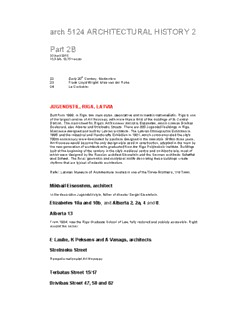
arch 5124 ARCHITECTURAL HISTORY 2 Part 2B PDF
Preview arch 5124 ARCHITECTURAL HISTORY 2 Part 2B
arch 5124 ARCHITECTURAL HISTORY 2 Part 2B 30 April 2015 15.3 Mb, 13,751 words 22 Early 20th Century. Modernism 23 Frank Lloyd Wright. Mies van der Rohe 24 Le Corbusier JUGENDSTIL, RIGA, LATVIA Built from 1899. In Riga, two main styles, decorative and romantic-nationalistic. Riga is one of the largest centres of Art Nouveau, with more than a third of the buildings of its Central District;. The main street for Riga's Art Nouveau district is Elizabetes, which crosses Brivibas Boulevard, also Alberta and Strelnieku Streets. There are 800 Jugendstil buildings in Riga. Most were designed and built by Latvian architects. The Latvian Ethnographic Exhibition in 1896 and the Industrial and Handicrafts Exhibition in 1901, which commemorated the city's 700th anniversary were dominated by pavilions designed in the new style. Within three years, Art Nouveau would become the only design style used in construction, adopted in the main by the new generation of architects who graduated from the Riga Polytechnic Institute. Buildings built at the beginning of the century in the city's medieval centre and on Alberta iela, most of which were designed by the Russian architect Eisenstein and the German architects Scheffel and Scheel. The floral, geometric and sculptural motifs decorating these buildings create rhythms that are typical of eclectic architecture. Refer: Latvian Museum of Architecture located in one of the Three Brothers, Old Town. Mikhail Eisenstein, architect In the decorative Jugendstil style, father of director Sergei Eisenstein. Elizabetes 10a and 10b, and Alberta 2, 2a, 4 and 8. Alberta 13 From 1904, now the Riga Graduate School of Law, fully restored and publicly accessible. Right around the corner: E Laube, K Peksens and A Vanags, architects Strelnieku Street Romantic-nationalist Art Nouveau. Terbatas Street 15/17 Brivibas Street 47, 58 and 62 Unidentified Art Nouveau, Riga, Latvia.1 1www.google.com.au/search?q=Riga.+art+nouveau.+images&tbm=isch&tbo=u&source=univ& sa=X&ei=G8j8Ub_SAYyTiQeHyoCwBQ&ved=0CDoQsAQ&biw=1583&bih=947 Architects: towards and since Modernism Current to 9 June 2012, for the latest version, refer separate file. 1. Engineering, Arts & Crafts Joseph Paxton (1803-65), Chatsworth and London, Engineering. Peter Ellis (1808-88), Liverpool, Engineering. Frederick Olmstead (1822-1903), New York, Picturesque public landscape. Philip Webb (1831-1915), London, Arts & Crafts, English Domestic Revival. Richard Norman Shaw (1831-1912), Edinburgh, London, Arts & Crafts and Queen Anne. Gustav Eiffiel (1832-1923), Paris, Engineering. William Le Baron Jenney (1832-1907), Chicago, architect and engineer, steel- frame. William Morris (1834-96), London, designer, entrepeneur and ploitical theorist, Arts & Crafts. Frantz Jourdain (1847 -1935) Paris, architect, art critic and man of letters. Engineering and Beaux Arts, designer of great department stores and theatres. Henry Hobson Richardson (1838-86), Chicago, Romanesque Revival. Otto Wagner (1841-1918), Vienna. Classicism, Secessionism. Camillo Sitte (1843-1903), Austro-Hungary. Odon Lechner (1845-1914), ‘Hungarian Gaudi.’ Daniel Hudson Burnham (1846-1912) of Burnham & Root (), Chicago, Engineering. Charles Harrison Townshend (1851-1928), London, anglicised Art Nouveau. Antonio Guardi (1852-1926), Barcelona, Art Nouveau, Mathematics, Expressionism. Louis Sullivan (1856-1924), of Adler & Sullivan (1879-95), Louis Sullivan (1895- 1919), Chicago, proto-Art Nouveau, Engineering. Hendrik Petrus Berlage (1856-1934), Amsterdam, Arts & Crafts. 2. Art Nouveau, Secessionism Charles Francis Annesley Voysey (1857-1941), English Domestic Revival. Cass Gilbert (1859-1934), Engineering. Rudolf Steiner (1861-1925), Expressionism. Baron Victor Horta (1861-1947), Brussels, Art Nouveau. Hermann Muthesius (1861-1927), Berlin, London, architect, author and diplomat, Arts-and-Crafts. Henri van de Velde (1863-1957), Belgium, Germany, Weimar, Educator, furniture designer & architect, Art Nouveau, Modernism. Sir Raymond Unwin (1863-1940), London, engineer, architect and town planner. Jules Lavirotte (1864-1924), Paris, Art Nouveau. Richard Petersen (b 1865-), German traffic engineer. H Baillie Scott (1865-1945), Isle of Man. Arts & Crafts, English Domestic Revival. Ragnar Östberg (1866-1945) Stockholm, national romanticist. Hector Guimard (1867-1942), Paris. Art Nouveau. Joseph Olbrich (1867-1908), Vienna, Secessionist. Charles Rennie Mackintosh (1868-1928), Glasgow. Art Nouveau, Secessionist. Greene & Greene (1896-1909), Charles Greene (1868-1957) and Henry Greene (1870-1954). Arts & Crafts. Sir Edwin Lutyens (1869-1944), Surrey, London and New Delhi. Arts-and-Crafts, Imperial Baroque Revival. Hans Poelzig (1869-1936), Berlin, Modernist and Expressionist. Albert Kahn (1869-1942) Detroit, industrial architect, stripped classical/modernist. Lars Sonck (1870-1956). Turku and Helsinki, Arts-and-Crafts, neo-Romanesque and Finnish National Romanticism. Joze Plecnik (1872, active: 1900-1957), Vienna, Belgrade, Prague and Ljubljana; Viennese Secession, early in-situ-concrete, classical forms in surprising ways. Robert Maillart (1872-1940), Zurich, civil engineer, reinforced concrete.
Description: